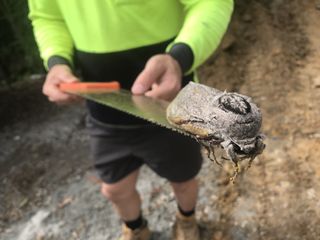Rarely seen supersized moth with 10-inch wingspan found at Australian school
The moth is so heavy, it can hardly fly.

A gigantic moth that is almost never seen by humans was recently found on a building site at a school in Australia. The colossal insect is so heavy that it can't fly, and reaches its full size just a few days before mating. And then it dies.
Giant wood moths (Endoxyla cinereus) are the largest species of moth in the world. When fully grown, the females, which are around twice the size of the males, can weigh up to 1 ounce (30 grams) and reach a wingspan of 10 inches (25 centimeters), according to the Australian Museum. They live in forests across Australia and New Zealand.
Builders working at Mount Cotton State School discovered the female giant wood moth on the construction site of a new school building near the edge of a rainforest. After photographing their impressive find, the builders placed the moth back in the wild.
Related: 7 insects you'll be eating in the future
Meagan Steward, the school's principal, described it as "an amazing find," but also said "they were not surprised" because they often have a wide range of animal visitors, including wallabies, koalas, ducks, snakes, tree frogs, possums and turtles, according to a statement from the school.
The larvae of these supersized insects, known commonly as witchetty grubs, burrow inside eucalyptus trees before reemerging around a year later as caterpillars that then use silky threads to lower themselves to the ground, where they feed on the tree's roots. The caterpillars then undergo a staggering metamorphosis and emerge in their gigantic final form, according to the Australian Museum.


After emerging, the smaller males are able to fly short distances and search out females to mate with on the ground. If reproduction is successful, the female will lay around 20,000 tiny eggs that will hatch to become witchetty grubs. However, the massive moths are rarely seen by people because they quickly die after the energetically expensive reproduction process, according to the Australian Museum.
Sign up for the Live Science daily newsletter now
Get the world’s most fascinating discoveries delivered straight to your inbox.
The school was closed when the moth was discovered, so students were not able to see the giant insect firsthand. However, photographs of the moth inspired a creative writing session that resulted in a story of a "giant moth invasion" that included their teacher "Mrs Wilson getting eaten," according to the school's statement.
Originally published on Live Science.

Harry is a U.K.-based senior staff writer at Live Science. He studied marine biology at the University of Exeter before training to become a journalist. He covers a wide range of topics including space exploration, planetary science, space weather, climate change, animal behavior, evolution and paleontology. His feature on the upcoming solar maximum was shortlisted in the "top scoop" category at the National Council for the Training of Journalists (NCTJ) Awards for Excellence in 2023.